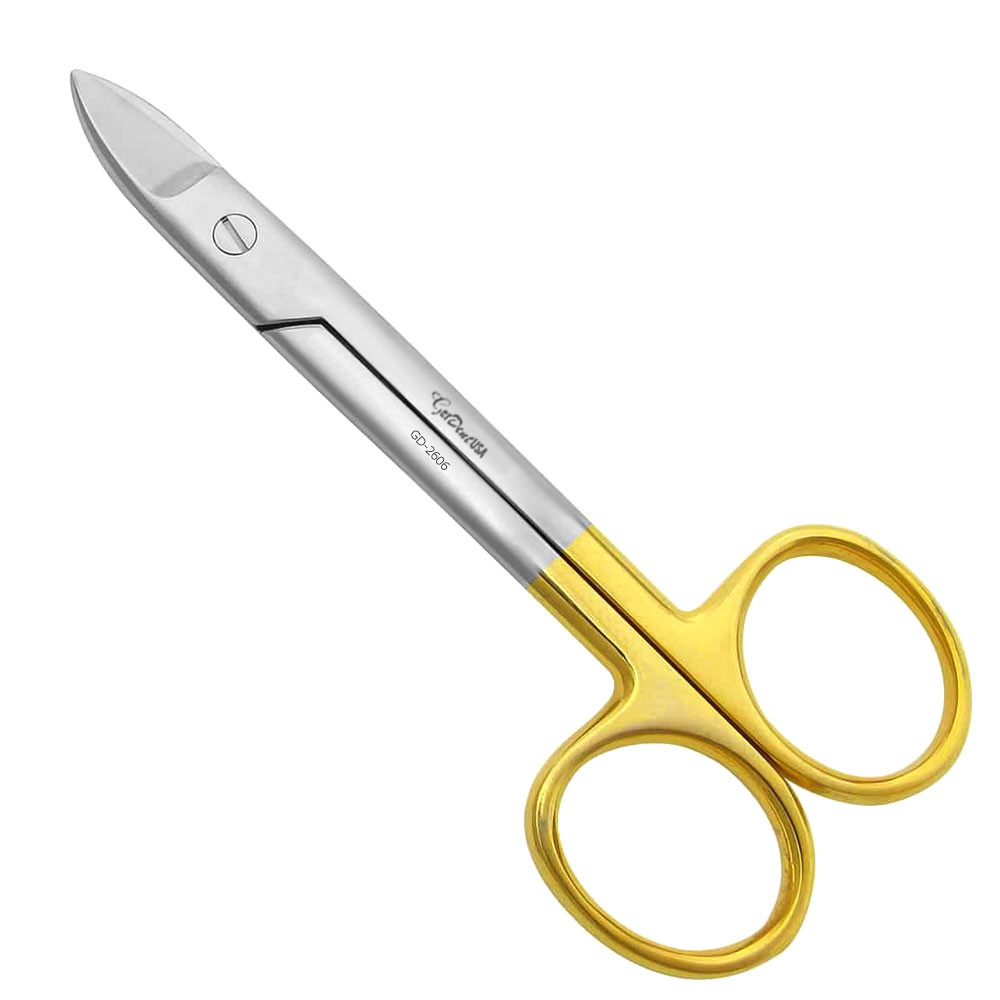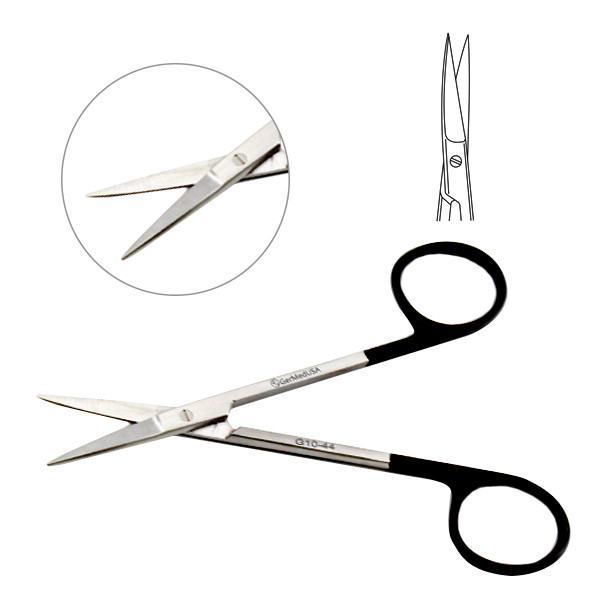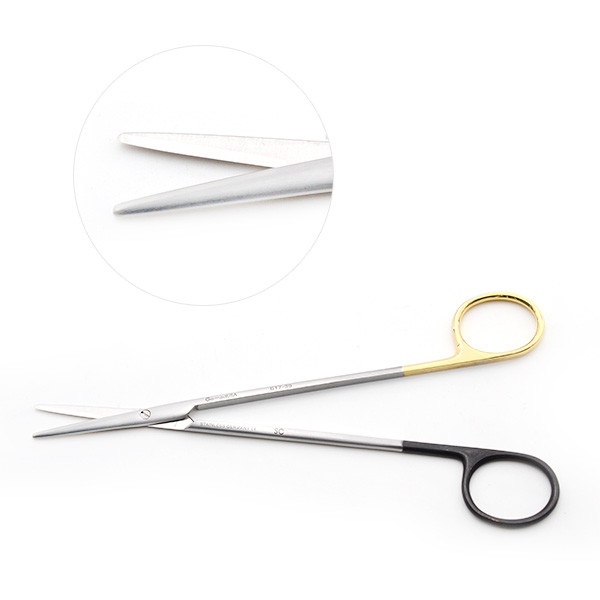In any surgical procedure, the use of scissors is common. Therefore, these are the most important surgical instruments.
For each procedure, medical professionals need a different type of scissors. For instance, if they have to cut skin or dense tissues, they will require mayo scissors. Similarly, they will use Metzenbaum scissors or Iris scissors for fine tissue dissection.
However, the requirement for suture cutting is much different. Neither Metz nor Mayo scissors will work there. The preference goes for suture scissors, also called stitch scissors. These are specially designed scissors instruments used in general medical procedures as well as dentistry.
Here, we’ll discuss some important concerns regarding these scissors.
So keep reading!
Use of Suture Scissors
Primarily, stitch scissors are helpful for dental professionals in
- Cutting sutures
- Removing sutures
- Resizing suture threads
Structure-wise, these suture removal scissors feature short blades. The lower one features a hook that lifts the suture up for cutting.
The long shank and finger ring handle of the scissors ensure improved control during the procedure.
Types of Stitch Scissors
According to the nature of the surgical site and the organ, the type of structure scissors varies.
For instance, medical professionals cannot use the same type of stitch scissors for removing stitches from eyelids and a skin incision.
Therefore, they need an instrument with specific features. Some common types of suture removal scissors are as follows:
- Standard Stitch Scissors
- Spencer Stitch Scissors
- Littauer Stitch Scissors
- Westcott Stitch Scissors
Each of these types has different structural features.
Apart from that, many size variations are also available for stitch removal surgical scissors.
Factors to Consider While Buying Suture Scissors
When buying suture removal scissors, medical professionals must consider some important factors. Doing so will help them choose the right instrument.
-
Blade Design
The perfect design of the scissors’ blades is crucial as it ensures effective cutting and precision.
Therefore, look for scissors with sharp, fine-tipped blades designed specifically for sutures.
Moreover, the blades should allow you to cut through sutures cleanly without causing damage to the surrounding tissues.
-
Material and Construction
The material and construction of the scissors play a significant role in their durability and performance.
High-quality stainless steel is commonly used for manufacturing surgical instruments as this material is more durable and resistant to corrosion.
Ensure the scissors are well-constructed and sturdy to withstand repetitive use and sterilization.
-
Size and Length
Suture scissors are available in various sizes and lengths to accommodate different surgical procedures.
Consider the size of your hand and the intended use of the scissors to determine the most appropriate length.
Longer scissors may provide better access in certain situations, while shorter ones offer more control in delicate procedures.
-
Holding and Handling Comfort
Since suture cutting and removing requires precision and attention to detail, it's essential to have comfortable scissors that fit well in your hand.
Therefore choose scissors with ergonomic handles that provide a secure grip and minimize hand fatigue during lengthy procedures.
-
Sterilization Compatibility
The suture scissors you choose for your practice must be sterilizable. This would ensure aseptic conditions in the operating room.
While buying, check if the scissors are compatible with standard sterilization methods such as autoclaving or chemical sterilization.
Some Other Commonly Used Surgical Scissors
There’re several types of scissors other than suture scissors that are helpful in both dentistry and general surgeries.
The most common are as follows.
-
Crown Scissors

These, also known as crown and bridge scissors, are commonly used in dental procedures.
Specifically, these dental scissors are designed for cutting and shaping dental materials such as
- Metal crowns
- Bridges
- Orthodontic wires
Crown scissors have a unique design with short blades and thick, sturdy handles. The blades allow dental professionals to cut and shape dental materials with improved precision.
The scissors' handle provides a secure grip and control during the procedure.
Crown or bridge scissors are an essential tool in dental labs and clinics, where they help in the precise fabrication and adjustment of dental prosthetics.
-
Dean Scissors
Dean scissors, or Dean dissecting scissors, are widely used in dentistry and other surgical procedures. They have long, thin, straight blades with delicate tips.
Primarily, these scissors are helpful in dissecting or separating delicate tissues.
Their long blades enable surgeons to reach hard-to-access areas. Moreover, the fine, pointed tips allow for precise and controlled dissection without causing trauma to surrounding tissues.
Commonly, these scissors are useful in dental procedures, plastic surgery, neurosurgery, and other procedures that require fine tissue manipulation.
-
Iris Scissors

Iris scissors are fine, delicate scissors with extensive use in ophthalmic surgeries and other procedures requiring intricate and precise tissue cutting.
Structure-wise, these scissors feature thin, sharp blades with either straight or curved tips.
Basically, Iris scissors are designed to
- Cut fine sutures
- Trim delicate tissues
- Work in small or hard-to-reach areas
The sharp blades and slender profile of iris scissors enable ophthalmic surgeons to perform microsurgical procedures, such as cataract surgery and corneal transplantations.
The choice between straight and curved tip iris scissors depends on the surgeon's preference and the specific requirements of the surgery.
For stitch removal in ophthalmic procedures, surgeons use iris suture scissors.
-
Kelly Scissors
Kelly scissors, also known as Kelly forceps scissors, are helpful in various medical specialties.
They have short, curved blades with one serrated edge. Medical professionals use Kelly scissors for cutting more rigid tissues, such as fascia or muscles.
The serrated edge of the scissors helps securely grip and hold tissues, reducing the chances of slippage while cutting them.
Primarily, these scissors are used in
- General surgery
- Orthopedics
- Gynecology procedures
The curved blades of Kelly scissors allow for better maneuverability and access to tissues in hard-to-reach anatomical sites.
-
Mayo Scissors
Mayo scissors are among the most commonly used surgical scissors.
They feature straight or curved, blunt-tipped blades with a relatively shorter shank.
Mayo dissecting scissors are valuable for various surgical procedures. They are particularly useful for cutting and dissecting dense tissues, skin, fat, and muscles.
Medical professionals can get these scissors in a variety of designs and sizes.
-
Metzenbaum Scissors

Metzenbaum scissors are useful in delicate surgical procedures, especially in plastic surgery and fine tissue dissection.
They have short blade-to-shank ratio with a finger ring handle. The blades of the scissors can be straight or curved.
The fine structure of Metz allows for precise cutting and is ideal for working in tight spaces or handling delicate tissues, preventing trauma.
Specifically, Metzenbaum scissors are useful in procedures like
- Breast surgery
- Neurosurgery
- Vascular surgery
Wrap Up!
Choosing the right suture scissors is crucial for removing stitches effectively.
Careful consideration of important factors ensures the selection of scissors that meet the specific surgical requirements of medical professionals.
If you need any general or dental scissors, we can provide you with the best quality to improve your dental practice and help you manage patient retention.
GerDentUSA Inc. has been manufacturing and supplying dental surgical instruments for the last three decades.
We take pride in fulfilling the requirements of dental professionals and serving the dentistry field.
Explore our website, choose what you need, and place your order now!

